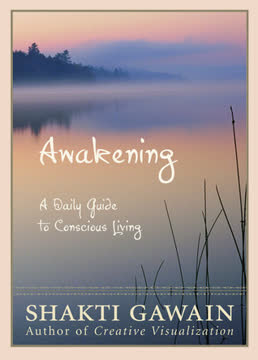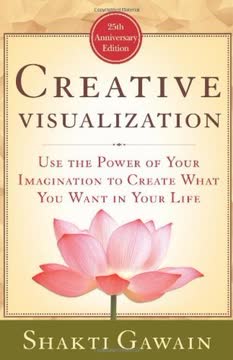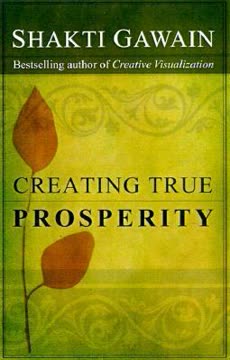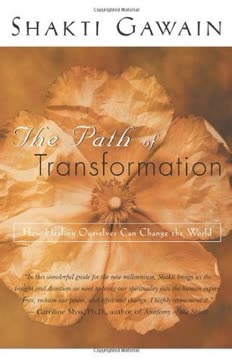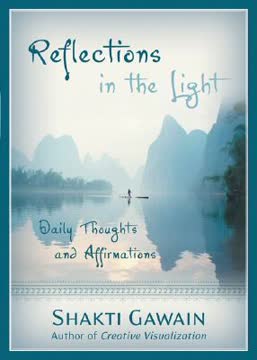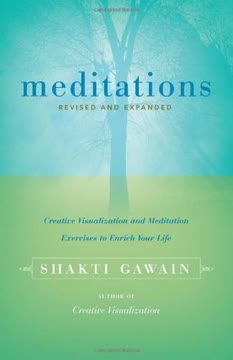Key Takeaways
1. Awakening to Consciousness: A Lifelong Journey of Self-Discovery
"Consciousness is not about fixing ourselves or improving ourselves. It's about coming to know ourselves in all our many aspects and thereby living life more fully."
Continuous awakening. The journey of consciousness is an ongoing process of becoming increasingly aware of what's happening inside us and around us. It's not about reaching a final destination, but rather embracing a lifelong path of growth and self-discovery. This journey involves:
- Recognizing and releasing old patterns and beliefs
- Opening to new ways of thinking and being in every area of our lives
- Integrating our essential spiritual wisdom into all levels of our being: mental, emotional, and physical
Self-acceptance and exploration. As we awaken, we learn to honor ourselves as unique and valid parts of the universe. This process encourages us to explore our inner worlds, acknowledge our desires, and set meaningful goals. By doing so, we begin to create our own reality consciously, rather than out of habit or old patterns.
2. Embracing the Inner Child: Key to Creativity and Emotional Healing
"The child within us is one of the most vital aspects of ourselves to contact, because it is closest to our spiritual essence."
Reconnecting with innocence. The inner child represents our emotional core, carrying our deepest feelings, creativity, and connection to our spiritual essence. By reconnecting with this part of ourselves, we can:
- Access our natural creativity and spontaneity
- Heal emotional wounds from the past
- Experience greater joy, playfulness, and authenticity in our lives
Nurturing the inner child. To embrace our inner child, we must create a safe and nurturing environment within ourselves. This involves:
- Listening to the child's needs and wants
- Providing love, protection, and emotional support
- Allowing for play and creative expression
- Honoring the child's feelings and intuitions
By caring for our inner child, we open ourselves to greater emotional depth, authenticity, and joy in our adult lives.
3. Balancing Masculine and Feminine Energies for Personal Growth
"Creativity is a blend of masculine and feminine energies. It's the receiving of that creative force (feminine) and the expression of it (masculine)."
Harmonizing opposites. Each person, regardless of gender, possesses both masculine and feminine energies. Achieving balance between these energies is crucial for personal growth and fulfillment. Masculine energy is associated with:
- Action, focus, and goal-oriented behavior
- Logic, structure, and discipline
Feminine energy is characterized by:
- Receptivity, intuition, and nurturing
- Creativity, flow, and emotional expression
Integrating energies. By consciously developing both aspects, we can:
- Enhance our creativity and problem-solving abilities
- Improve our relationships and communication skills
- Achieve greater balance in our personal and professional lives
To integrate these energies, practice activities that cultivate both sides, such as combining meditation (feminine) with goal-setting (masculine), or balancing nurturing relationships (feminine) with assertive self-expression (masculine).
4. Relationships as Mirrors: Learning from Every Interaction
"Our relationships can be the fastest and the most powerful route to the deepest truths, if we know how to use them."
Self-reflection through others. Our relationships serve as powerful mirrors, reflecting aspects of ourselves that we may not be able to see directly. This includes:
- Qualities we admire in others (reflecting our own potential)
- Traits that irritate us (often representing disowned parts of ourselves)
- Patterns in our interactions (revealing our beliefs and expectations)
Growth through connection. By viewing our relationships as opportunities for self-discovery and growth, we can:
- Gain deeper self-awareness
- Heal emotional wounds
- Develop greater empathy and understanding for others
- Cultivate more authentic and fulfilling connections
To harness this power, practice observing your reactions in relationships without judgment, and ask yourself what each interaction might be teaching you about yourself.
5. Honoring All Aspects of Self: Integrating Light and Shadow
"Living in the light means bringing the light into every aspect of life — including the unconscious places that have been dark."
Embracing wholeness. True personal growth involves acknowledging and integrating all aspects of ourselves, including those we've previously rejected or feared. This process of integration:
- Allows us to access our full range of emotions and experiences
- Releases energy previously used to repress unwanted aspects
- Leads to greater authenticity and personal power
Shadow work. To integrate our shadow aspects:
- Identify repressed or disowned parts of yourself
- Acknowledge the positive intentions behind these aspects
- Find healthy ways to express and channel these energies
- Practice self-compassion and acceptance throughout the process
Remember that what we resist persists. By embracing all parts of ourselves, we become more whole and balanced individuals.
6. The Four Levels of Being: Spiritual, Mental, Emotional, and Physical
"In order to truly heal ourselves and the world, we must heal all four levels and bring them into balance and integration."
Holistic healing. True healing and personal growth involve addressing all four levels of our being:
- Spiritual: Reconnecting with our essence and universal source
- Mental: Examining and updating our beliefs and thought patterns
- Emotional: Allowing and processing our full range of feelings
- Physical: Listening to and honoring our body's needs and wisdom
Integrated approach. To achieve balance and wholeness:
- Recognize the interconnectedness of all levels
- Address each level individually and in relation to the others
- Create practices that support growth on multiple levels simultaneously (e.g., yoga for physical and spiritual growth)
- Be patient and consistent, as healing is an ongoing process
By attending to all four levels, we create a solid foundation for lasting transformation and well-being.
7. Cultivating Authenticity: The Path to True Fulfillment
"To be creative, it is essential to take some risks."
Embracing true self. Authenticity is the cornerstone of a fulfilling life. It involves:
- Being honest with ourselves about our thoughts, feelings, and desires
- Expressing our truth in our relationships and interactions
- Aligning our actions with our values and inner wisdom
Overcoming fears. To cultivate authenticity:
- Identify and challenge limiting beliefs about self-expression
- Practice vulnerability in safe environments
- Develop self-trust by honoring your intuition and feelings
- Celebrate your unique qualities and perspectives
Remember that authenticity is a practice, not a destination. Each authentic choice builds confidence and opens doors to greater self-expression and fulfillment.
8. Navigating Life's Challenges: Embracing Change and Uncertainty
"Growth is a cyclical process. Each time you go through a difficult stage, you experience a dark night. Then you come into a morning, and things feel good and easy for awhile."
Cycles of growth. Life's challenges are opportunities for growth and transformation. Understanding the cyclical nature of growth can help us:
- Maintain perspective during difficult times
- Trust in the process of change and renewal
- Develop resilience and adaptability
Embracing uncertainty. To navigate life's challenges more effectively:
- Cultivate mindfulness to stay present during difficult emotions
- Practice self-compassion during periods of struggle
- Seek support from trusted friends, family, or professionals
- Look for lessons and opportunities for growth in each experience
Remember that confusion and discomfort often precede breakthroughs. By staying open and curious during challenging times, we allow for deeper insights and personal evolution.
9. Creating True Prosperity: Aligning with Universal Energy Flow
"As I listen to my higher guidance, money flows into my life."
Redefining wealth. True prosperity goes beyond financial abundance to encompass:
- Fulfilling relationships
- Creative expression
- Emotional well-being
- Spiritual connection
- Physical health
Aligning with universal flow. To create true prosperity:
- Clarify your values and priorities
- Trust your intuition and inner guidance
- Take inspired action towards your goals
- Cultivate gratitude for what you already have
- Maintain an open and generous attitude towards giving and receiving
By aligning with the natural flow of universal energy, we create space for abundance in all areas of our lives. This alignment allows us to receive the resources, opportunities, and support needed to fulfill our deepest purpose and contribute to the world in meaningful ways.
Last updated:
FAQ
1. What is "Awakening: A Daily Guide to Conscious Living" by Shakti Gawain about?
- Daily guide to conscious living: The book offers 365 daily entries designed to help readers live more consciously, integrating spiritual wisdom into everyday life.
- Focus on self-awareness and growth: It emphasizes the importance of self-actualization, personal responsibility, and aligning with universal principles for a balanced, harmonious life.
- Themes of integration and healing: Gawain explores integrating mental, emotional, physical, and spiritual aspects of the self, encouraging readers to embrace all parts of themselves.
- Practical affirmations and exercises: Each entry includes an affirmation, question, or exercise to help readers reflect and apply the concepts in their daily routines.
2. Why should I read "Awakening: A Daily Guide to Conscious Living" by Shakti Gawain?
- Accessible daily format: The book is structured for easy, daily reading, making it practical for busy lives and ongoing personal development.
- Holistic approach to growth: Gawain addresses not just spiritual growth, but also emotional healing, physical well-being, and mental clarity.
- Tools for self-discovery: Readers gain practical tools—like affirmations, journaling prompts, and meditations—to deepen self-awareness and foster positive change.
- Support for life’s challenges: The book provides guidance for navigating struggles, embracing vulnerability, and finding meaning in both positive and difficult experiences.
3. What are the key takeaways from "Awakening: A Daily Guide to Conscious Living"?
- Consciousness is a lifelong journey: Personal growth and awakening are ongoing processes, not destinations, requiring patience and self-compassion.
- Integration of all aspects: True wholeness comes from embracing and balancing all parts of oneself, including the shadow, inner child, and both masculine and feminine energies.
- Relationships as mirrors: Our interactions with others reflect our inner world, offering opportunities for self-discovery and healing.
- Practical daily practices: Small, consistent actions—like affirmations, meditation, and self-reflection—can lead to profound transformation over time.
4. How does Shakti Gawain define "conscious living" in "Awakening: A Daily Guide to Conscious Living"?
- Living with awareness: Conscious living means being aware of your thoughts, feelings, actions, and the impact they have on yourself and the world.
- Responsibility for your reality: Gawain teaches that we create our own reality, consciously or unconsciously, and encourages taking responsibility for our choices.
- Integration of spiritual wisdom: It involves connecting with your inner guidance or intuition and integrating spiritual insights into everyday decisions.
- Openness to growth and change: Conscious living requires a willingness to examine old patterns, embrace new perspectives, and continually evolve.
5. What is the role of affirmations and daily exercises in "Awakening: A Daily Guide to Conscious Living"?
- Daily focus and intention: Affirmations help set a positive tone for the day, focusing the mind on growth and healing.
- Encouragement of self-reflection: Questions and exercises prompt readers to explore their beliefs, feelings, and behaviors, fostering deeper self-understanding.
- Practical application: These tools bridge the gap between theory and practice, making spiritual concepts actionable in daily life.
- Support for habit change: Repetition of affirmations and exercises helps rewire thought patterns and supports lasting transformation.
6. How does "Awakening: A Daily Guide to Conscious Living" by Shakti Gawain address the concept of the "inner child"?
- Inner child as emotional core: The book describes the inner child as the source of sensitivity, creativity, vulnerability, and deep feelings.
- Healing and nurturing: Gawain emphasizes the importance of recognizing, loving, and caring for the inner child to achieve emotional healing and authenticity.
- Practical exercises: Readers are guided to contact, communicate with, and fulfill the needs of their inner child through visualization, play, and self-parenting.
- Connection to creativity and spirit: The inner child is seen as a bridge to both creativity and spiritual essence, making its integration vital for wholeness.
7. What does Shakti Gawain mean by "embracing polarities" or "balancing masculine and feminine energies" in "Awakening: A Daily Guide to Conscious Living"?
- Duality as natural: Gawain explains that life is filled with polarities (e.g., masculine/feminine, doing/being, rational/intuitive), and both are necessary for wholeness.
- Integration for balance: True consciousness involves embracing both sides of each polarity within oneself, rather than identifying with only one.
- Practical balance: The book offers exercises to help readers recognize their dominant energies and develop their less-expressed sides for greater harmony.
- Impact on relationships and creativity: Balancing these energies enhances relationships, creativity, and the ability to manifest desires in the world.
8. How does "Awakening: A Daily Guide to Conscious Living" by Shakti Gawain approach emotional healing and the "shadow"?
- Shadow as disowned self: The shadow consists of parts of ourselves we have repressed or denied, often due to societal or familial disapproval.
- Necessity of acceptance: Healing requires acknowledging, accepting, and integrating these shadow aspects rather than rejecting them.
- Emotional honesty: Gawain encourages feeling and expressing all emotions—including sadness, anger, and fear—as essential steps toward healing.
- Transformation through awareness: By bringing light to the shadow, we reclaim lost energy and move toward greater wholeness and authenticity.
9. What is the significance of relationships and "mirroring" in "Awakening: A Daily Guide to Conscious Living"?
- Relationships as mirrors: Gawain teaches that our relationships reflect our inner world, showing us both our strengths and areas needing growth.
- Opportunities for self-discovery: Conflicts and attractions in relationships reveal disowned or undeveloped aspects of ourselves.
- Path to integration: By recognizing what others mirror for us, we can consciously integrate those qualities and achieve greater balance.
- Universal application: This mirroring principle applies to all relationships—romantic, familial, professional, and even societal.
10. How does "Awakening: A Daily Guide to Conscious Living" by Shakti Gawain suggest we work with the "inner critic" and perfectionism?
- Awareness as the first step: Recognizing the voice of the inner critic and understanding its origins (often from childhood) is essential.
- Separation from criticism: Gawain advises developing a healthy distance from the critic, questioning its validity, and not letting it control your life.
- Cultivating supportive voices: The book encourages balancing the critic with positive, encouraging self-talk and affirmations.
- Redefining perfection: Perfection is reframed as being present in the process of growth, not in achieving flawless results.
11. What are some of the most impactful quotes from "Awakening: A Daily Guide to Conscious Living" by Shakti Gawain, and what do they mean?
- "Each day, and each year, I am awakening to greater consciousness." – This highlights the ongoing, incremental nature of personal growth.
- "Life is my school, and I’m here to learn." – Emphasizes that every experience, positive or negative, is an opportunity for learning and evolution.
- "I am learning to accept all sides of myself." – Encourages embracing both light and shadow aspects for true self-acceptance.
- "Through my inner child, I am in contact with my soul." – Suggests that reconnecting with innocence and vulnerability leads to spiritual depth.
- "I am the artist of my life." – Reminds readers of their creative power and responsibility in shaping their own reality.
12. How can readers best use "Awakening: A Daily Guide to Conscious Living" by Shakti Gawain for personal transformation?
- Daily reading practice: Gawain recommends reading one entry each morning and reflecting on the affirmation or question throughout the day.
- Personalization of affirmations: If a suggested affirmation doesn’t resonate, readers are encouraged to create their own that feel authentic.
- Journaling and self-inquiry: Writing down thoughts and feelings that arise from each entry deepens the process of self-discovery.
- Ongoing, flexible use: The book is designed for repeated use, allowing readers to revisit entries as their understanding and life circumstances evolve.
Review Summary
Readers highly praise Awakening as a daily devotional that offers thought-provoking reflections and affirmations. Many have found it to be a long-term companion, helping them on their personal journey and providing inspiration each day. The book is described as setting a positive tone for the day and guiding readers through inner work. While most reviews are overwhelmingly positive, one critic suggests some content may be of lower quality. Overall, readers appreciate the book's ability to promote harmony, self-reflection, and personal growth.
Download PDF
Download EPUB
.epub digital book format is ideal for reading ebooks on phones, tablets, and e-readers.
